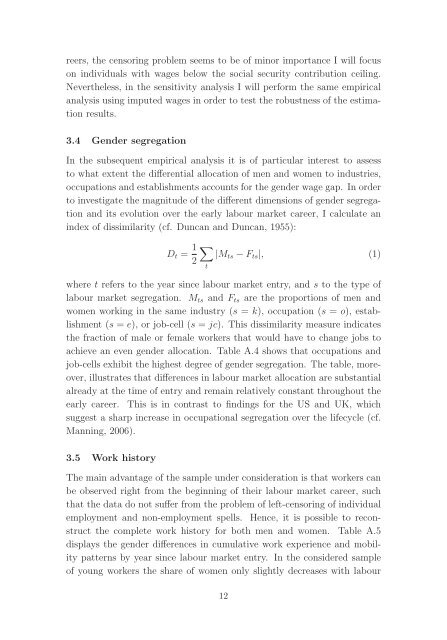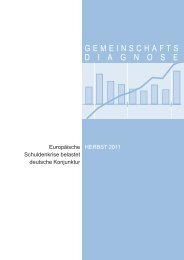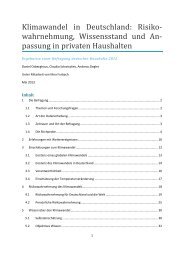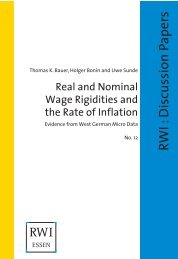Gender Segregation and Gender Wage Differences during the Early ...
Gender Segregation and Gender Wage Differences during the Early ...
Gender Segregation and Gender Wage Differences during the Early ...
Create successful ePaper yourself
Turn your PDF publications into a flip-book with our unique Google optimized e-Paper software.
eers, <strong>the</strong> censoring problem seems to be of minor importance I will focus<br />
on individuals with wages below <strong>the</strong> social security contribution ceiling.<br />
Never<strong>the</strong>less, in <strong>the</strong> sensitivity analysis I will perform <strong>the</strong> same empirical<br />
analysis using imputed wages in order to test <strong>the</strong> robustness of <strong>the</strong> estimation<br />
results.<br />
3.4 <strong>Gender</strong> segregation<br />
In <strong>the</strong> subsequent empirical analysis it is of particular interest to assess<br />
to what extent <strong>the</strong> differential allocation of men <strong>and</strong> women to industries,<br />
occupations <strong>and</strong> establishments accounts for <strong>the</strong> gender wage gap. In order<br />
to investigate <strong>the</strong> magnitude of <strong>the</strong> different dimensions of gender segregation<br />
<strong>and</strong> its evolution over <strong>the</strong> early labour market career, I calculate an<br />
index of dissimilarity (cf. Duncan <strong>and</strong> Duncan, 1955):<br />
D t = 1 ∑<br />
|M ts − F ts |, (1)<br />
2<br />
t<br />
where t refers to <strong>the</strong> year since labour market entry, <strong>and</strong> s to <strong>the</strong> type of<br />
labour market segregation. M ts <strong>and</strong> F ts are <strong>the</strong> proportions of men <strong>and</strong><br />
women working in <strong>the</strong> same industry (s = k), occupation (s = o), establishment<br />
(s = e), or job-cell (s = jc). This dissimilarity measure indicates<br />
<strong>the</strong> fraction of male or female workers that would have to change jobs to<br />
achieve an even gender allocation. Table A.4 shows that occupations <strong>and</strong><br />
job-cells exhibit <strong>the</strong> highest degree of gender segregation. The table, moreover,<br />
illustrates that differences in labour market allocation are substantial<br />
already at <strong>the</strong> time of entry <strong>and</strong> remain relatively constant throughout <strong>the</strong><br />
early career. This is in contrast to findings for <strong>the</strong> US <strong>and</strong> UK, which<br />
suggest a sharp increase in occupational segregation over <strong>the</strong> lifecycle (cf.<br />
Manning, 2006).<br />
3.5 Work history<br />
The main advantage of <strong>the</strong> sample under consideration is that workers can<br />
be observed right from <strong>the</strong> beginning of <strong>the</strong>ir labour market career, such<br />
that <strong>the</strong> data do not suffer from <strong>the</strong> problem of left-censoring of individual<br />
employment <strong>and</strong> non-employment spells. Hence, it is possible to reconstruct<br />
<strong>the</strong> complete work history for both men <strong>and</strong> women. Table A.5<br />
displays <strong>the</strong> gender differences in cumulative work experience <strong>and</strong> mobility<br />
patterns by year since labour market entry. In <strong>the</strong> considered sample<br />
of young workers <strong>the</strong> share of women only slightly decreases with labour<br />
12
















